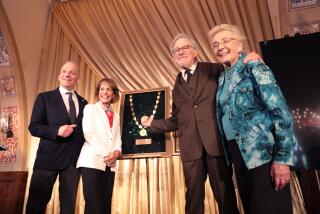Event Looks at Growth of Hate Sites
- Share via
Perhaps without even meaning to, the Simon Wiesenthal Center showed computer technology at its best and its worst during its conference on the Internet.
Using a flawless videoconference link from Washington, Rabbi Abraham Cooper, the center’s associate dean, served as master of ceremonies for the event at the Museum of Tolerance in Los Angeles. At the same time, another videoconference link brought together educators from Connecticut, Minnesota, Missouri, New Jersey and Washington. And a World Wide Web cybercast drew in even more people.
All of which was slightly ironic, considering that last week’s “Internet 2000: Promise and Peril” conference focused on the decidedly negative message of how hate groups are using computer networking technology to spread their message of white supremacy.
“Extremists are able to embrace this technology in an extraordinarily sophisticated way,” Cooper said.
The trend can be traced to the 1980s, when former Ku Klux Klan and Aryan Nations leader Louis Beam was thought to have set up a computer bulletin board system to drum up support for the radical militia movement.
Liebe Geft, director of the Museum of Tolerance, said the number of hate sites on the Web has ballooned from only one at the start of the Persian Gulf War in 1991 to more than 1,000 today--mirroring the explosive growth of the global computer network itself.
As evidence, Rick Eaton, a senior research associate at the Wiesenthal Center, led participants in the one-day conference on a tour of hate sites on the Internet. He began at Stormfront (https://www.stormfront.org), which he described as the oldest hate site on the Web.
The site has links to articles that are made to look “mainstream and educational but are usually a front for white supremacy,” Eaton said.
A perhaps more blatant stop on Eaton’s tour was Resistance Records (https://www.resistance.com), where visitors can sample and order CDs and cassettes with titles like “White, Straight & Proud” by New Minority, “Born to Hate” by Nordic Thunder, and “For Segregationists Only” by Johnny Rebel.
The biggest danger, Eaton said, is that unsuspecting Web surfers will encounter a hate site without realizing it and mistake opinion for fact. For instance, a person who uses the Excite search engine to find out about the Auschwitz concentration camp will find a link to a site titled “Why Wasn’t Auschwitz Bombed?” The site--https://www.air-photo.com/english/ra/aushwitz.html--uses aerial photography to argue that there were no gas chambers at the camp where an estimated 1.5 million Jews and others perished at the hands of the Nazis.
Despite concerns raised about the content on these and other sites, most of the guests invited to speak at the conference spoke out firmly against government regulation to curb hate speech on the Internet.
“Although the temptation is great to look to legislation and regulation to combat cyberhate . . . our commitment to free speech must always take precedence over our fears,” said Raymond Smith, chairman of New York-based phone giant Bell Atlantic, which operates an Internet service. “Instead of fearing the Internet’s reach, I believe we have to embrace it. We need to think less about ways to keep cyberhate off the screen and more about ways to fight it head on.”
That view was shared by Mark Greenberg, an assistant U.S. attorney in Los Angeles who has prosecuted skinheads.
“For all the benefits fire has brought to society, we don’t do away with fire because it’s dangerous to children,” he said. “Instead, we teach children about the dangers of fire.”
Instead of government regulation, most speakers emphasized the responsibility of parents and teachers to make children aware of hate speech on the Internet. To that end, the Wiesenthal Center next month will issue “Digital Hate 2000,” its second CD-ROM cataloging hate sites on the Web.
“Part of our mandate is to track and expose hate groups,” Cooper said. “The problems are not new, but the potential harm is unprecedented due to the technology.”
*
Times staff writer Karen Kaplan can be reached via e-mail at karen.kaplan@latimes.com.







